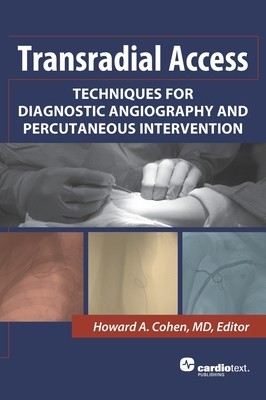
- We will send in 10–14 business days.
- Publisher: Cardiotext Inc
- Year: 2013
- Pages: 224
- ISBN-10: 1935395416
- ISBN-13: 9781935395416
- Format: 17.8 x 25.4 x 1.4 cm, kieti viršeliai
- Language: English
- SAVE -10% with code: EXTRA
Transradial Access (e-book) (used book) | bookbook.eu
Reviews
Description
Transradial Access: Techniques for Diagnostic Angiography and Percutaneous Intervention offers a single source for both novice and experienced interventional cardiologists for safely and effectively performing transradial catheterization procedures. First described in 1989, the transradial approach for coronary angiography and percutaneous interventions has seen a constant and progressive increase around the world as a result of significantly reduced procedural complications, shorter hospital stays, increased patient satisfaction, and lower associated costs compared with the transfemoral approach.
Yet despite its apparent benefits, adoption of this technique in the United States has been slow, largely due to the increased technical aspects of entering a smaller artery, accessing the central circulation and engaging the coronary arteries from this approach. In addition, until recently the technique was not routinely taught in the majority of training programs. This book flattens that learning curve by highlighting the technical aspects of transradial diagnostic and interventional procedures, and includes detailed discussion of:
- Normal vascular anatomy of the hand and arm
- Indications and contraindications for transradial access procedures
- Patient and catheter selection
- Tips and tricks for both beginner and advanced operators
- Procedural pitfalls and potential complications
Techniques are demonstrated in detail using both still images and video. Whether you are an experienced transfemoral operator who wants to refine and expand your technique or a new transradial operator looking to master the technique, this comprehensive text holds the key to mastering this revolutionary procedure.
EXTRA 10 % discount with code: EXTRA
The promotion ends in 21d.02:18:21
The discount code is valid when purchasing from 10 €. Discounts do not stack.
- Publisher: Cardiotext Inc
- Year: 2013
- Pages: 224
- ISBN-10: 1935395416
- ISBN-13: 9781935395416
- Format: 17.8 x 25.4 x 1.4 cm, kieti viršeliai
- Language: English English
Transradial Access: Techniques for Diagnostic Angiography and Percutaneous Intervention offers a single source for both novice and experienced interventional cardiologists for safely and effectively performing transradial catheterization procedures. First described in 1989, the transradial approach for coronary angiography and percutaneous interventions has seen a constant and progressive increase around the world as a result of significantly reduced procedural complications, shorter hospital stays, increased patient satisfaction, and lower associated costs compared with the transfemoral approach.
Yet despite its apparent benefits, adoption of this technique in the United States has been slow, largely due to the increased technical aspects of entering a smaller artery, accessing the central circulation and engaging the coronary arteries from this approach. In addition, until recently the technique was not routinely taught in the majority of training programs. This book flattens that learning curve by highlighting the technical aspects of transradial diagnostic and interventional procedures, and includes detailed discussion of:
- Normal vascular anatomy of the hand and arm
- Indications and contraindications for transradial access procedures
- Patient and catheter selection
- Tips and tricks for both beginner and advanced operators
- Procedural pitfalls and potential complications
Techniques are demonstrated in detail using both still images and video. Whether you are an experienced transfemoral operator who wants to refine and expand your technique or a new transradial operator looking to master the technique, this comprehensive text holds the key to mastering this revolutionary procedure.


Reviews